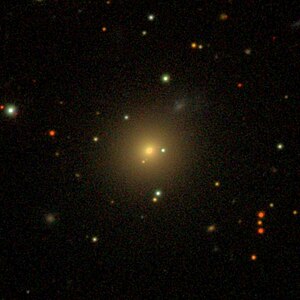NGC 233
| Galaxy NGC 233 |
|
|---|---|

|
|
| SDSS recording | |
| AladinLite | |
| Constellation | Andromeda |
|
Position equinox : J2000.0 , epoch : J2000.0 |
|
| Right ascension | 00 h 43 m 36.5 s |
| declination | + 30 ° 35 ′ 13 ″ |
| Appearance | |
| Morphological type | E? |
| Brightness (visual) | 12.8 mag |
| Brightness (B-band) | 13.8 mag |
| Angular expansion | 1.2 ′ × 1.2 ′ |
| Surface brightness | 13.3 mag / arcmin² |
| Physical data | |
| Affiliation | NGC 266 group NGC 315 group LGG 14 |
| Redshift | 0.018086 ± 0.000090 |
| Radial velocity | 5422 ± 27 km / s |
|
Stroke distance v rad / H 0 |
(250 ± 18) x 10 6 ly (76.5 ± 5.4) Mpc |
| history | |
| discovery | Wilhelm Herschel |
| Discovery date | September 11, 1784 |
| Catalog names | |
| NGC 233 • UGC 464 • PGC 2604 • CGCG 500-078 • MCG + 05-02-041 • 2MASX J00433654 + 3035132 • GC 124 • H III 149 • h 54 • GALEXASC J004600.83 + 295736.5 • LDCE 39 NED008 | |
NGC 233 is an elliptical galaxy from the Hubble type E0 in the constellation Andromeda the northern sky . It is estimated to be 250 million light years from the Milky Way and about 85,000 light years in diameter.
The galaxies NGC 243 and IC 43 are located in the same area of the sky .
The object was discovered on September 11, 1784 by the German-British astronomer Wilhelm Herschel .
Web links
Commons : NGC 233 - collection of images, videos, and audio files
